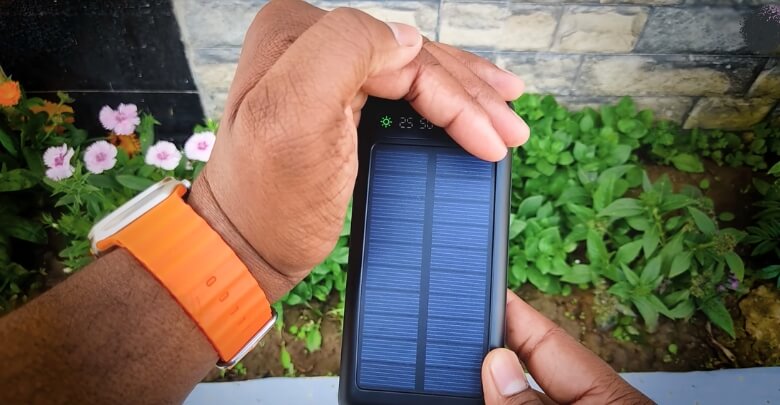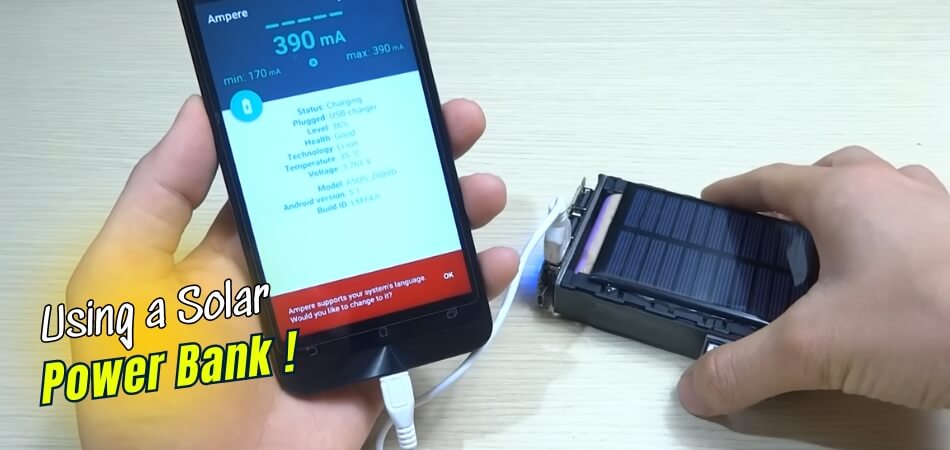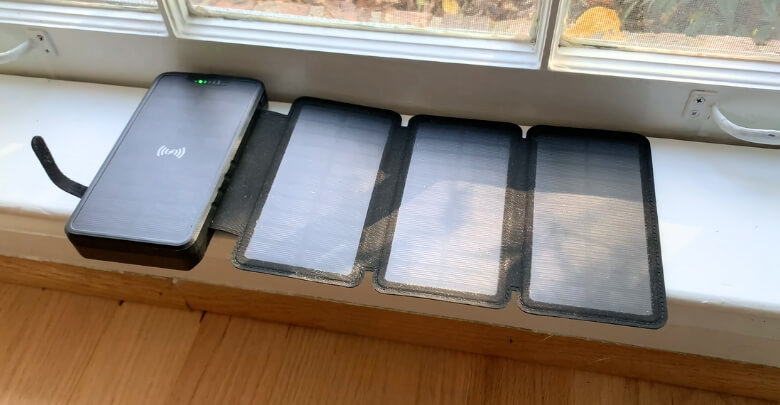The gadgets we use today play a crucial role in staying connected in today’s fast-paced world. From smartphones to tablets, these devices keep us in the loop, but they all share one common need: power. That’s where the solar power bank comes into the picture. A sustainable and convenient solution, it harnesses sunlight to keep your gadgets charged on the go. But how to Use a Solar Power Bank?
The process is straightforward: begin by charging it with a USB charger or by exposing it to direct sunlight. The power bank will charge your device once it’s charged, so connect your device using a compatible cable and press the power button.
Stay tuned for more tips on making the most of this eco-friendly charging option.
Solar Power Bank: What is The Basics?
A solar power bank is a portable device that uses solar panels to convert sunlight into electricity. It stores this energy in a built-in battery, which you can use to charge your gadgets like smartphones, tablets, and cameras. The best part? It’s an eco-friendly option, harnessing renewable energy from the sun.

Most solar power banks also come with USB ports, so you can charge them using a wall charger when there’s no sunlight available. They’re perfect for outdoor adventures, travel, or just as a backup power source. With a solar power bank, you’re not just keeping your devices powered up; you’re also doing your bit for the environment by using a clean, sustainable energy source.
Hence, next time you are packing for a trip or going on an outdoor adventure, consider taking a solar power bank along. It’s a small step towards a greener lifestyle and ensures you stay connected, no matter where you are.
Why Should You Opt for a Solar Power Bank?
We live in a world where staying connected is crucial, and a solar power bank is your reliable partner in this mission. It’s a device that uses solar panels to convert sunlight into electrical energy, storing it in a battery for later use. Here’s why you should consider one.

Eco-Friendly Choice
Solar power banks are a green alternative. They harness renewable energy from the sun, reducing your carbon footprint. By using solar power, you contribute to a cleaner, more sustainable environment. It’s a small step with a big impact.
Convenience on the Go
When you’re hiking or at a festival, and your phone dies, what would you do? Solar power banks are your savior. It’s portable, easy to use, and ensures your devices stay charged, no matter where you are. You’re never stranded without power.
Cost-Effective in the Long Run
While the initial investment might be higher, solar power banks save you money over time. You’re not reliant on electricity to charge your devices, which means lower energy bills. Plus, with the sun as your energy source, you’re tapping into a free resource.
To keep your gadgets charged, a solar power bank is a convenient, cost-efficient, and sustainable option. It’s a smart choice for both the environment and your wallet.
How to Use a Solar Power Bank?
Solar power banks are the perfect companions for anyone on the go, offering a sustainable and convenient way to keep your devices charged. But how do you use a solar power bank? It’s simpler than you might think. To harness the power of the sun for your gadgets, we’ll walk you through the key steps.

Step 1: Charging Your Solar Power Bank
Before you can use your solar power bank to charge your devices, you need to charge the bank itself. Place it in direct sunlight, with the solar panels facing up, to capture the sun’s energy. This process can take several hours, so it’s a good idea to charge your solar power bank during the day when sunlight is abundant.
Step 2: Connecting Your Device
Once your solar power bank is charged, you can use it to power your devices. Simply connect your device to the power bank using a compatible USB cable. Ensure the cable is securely plugged into both the power bank and your device for a stable connection.
Step 3: Starting the Charging Process
After connecting your device, press the power button on the solar power bank to start charging. Some power banks start charging automatically, while others require you to press a button. Keep an eye on your device’s battery indicator to ensure it’s charging properly.
Step 4: Monitoring the Charge
While your device is charging, it’s important to monitor the progress. Most solar power banks have LED indicators that show the charging status and battery level. If the power bank gets too hot or the charging seems slow, reposition it to a cooler spot or adjust the angle to get better sunlight exposure.
Step 5: Disconnecting Your Device
Once your device is fully charged, disconnect it from the solar power bank. This helps preserve the power bank’s battery life and ensures it’s ready for the next use. Remember to turn off the power bank if it has an on/off switch to save energy.
Step 6: Maintaining Your Solar Power Bank
To keep your solar power bank in top condition, clean the solar panels regularly with a soft, dry cloth. This removes any dust or debris that could block sunlight. Avoid exposing the power bank to extreme temperatures or moisture, as this can damage the battery and reduce its efficiency.
Step 7: Safety Tips
When using a solar power bank, keep it away from fire, water, and sharp objects. Don’t attempt to open or repair the power bank yourself, as this can be dangerous. If you encounter any issues, contact the manufacturer for assistance.
By following these simple steps, you can make the most of your solar power bank and enjoy the convenience of portable, eco-friendly power. Whether you’re camping, traveling, or just out and about, a solar power bank is a reliable way to keep your devices charged and ready to go.
Why Solar Power Banks Are Beneficial?
Solar power banks are more than just portable chargers; they’re a smart choice for anyone looking to stay connected while being eco-friendly. Here are some of the top benefits of using solar power banks.

- Eco-Friendly: Solar power banks use renewable energy from the sun, reducing your carbon footprint and contributing to a healthier environment.
- Convenient: They’re perfect for outdoor activities like camping, hiking, or festivals, where access to electricity might be limited. With a solar power bank, you can charge your devices anywhere there’s sunlight.
- Cost-Effective: Over time, using a solar power bank can save you money on electricity bills, as you’re harnessing free energy from the sun.
- Emergency Preparedness: In case of power outages or emergencies, a solar power bank can be a lifesaver, ensuring your devices stay charged when you need them most.
- Portable: Solar power banks are designed to be lightweight and compact, making them easy to carry in your bag or backpack.
- Versatile: They can charge a variety of devices, including smartphones, tablets, cameras, and even some laptops.
The solar power bank isn’t just for charging your devices; it’s also a way to contribute to the environment and lead a sustainable life.
FAQs About How to Use a Solar Power Bank?
Charging your phone when the charging port is not working can be a frustrating experience. However, there are alternative methods to keep your device powered up. Here are some frequently asked questions and their answers on this topic:
How Long Does It Take to Fully Charge a Solar Power Bank?
As a rule of thumb, attempting to fully charge a 20000mAh solar power bank via USB can take anywhere between 8-10 hours.
How Long Do Solar Bank Batteries Last?
Solar bank batteries have a lifespan of between five to 15 years, depending on usage and maintenance.
Can I Use a Wireless Charger if My Phone’s Charging Port is Not Working?
Yes, if your phone supports wireless charging, you can use a wireless charger like ChargeHubGo+ as an alternative to the traditional charging port.
Is It Possible to Charge My Phone Through the Usb Port on a Computer if the Charging Port is Not Working?
If the issue is with the charging port itself, charging through a computer’s USB port may not work. However, if the problem is with the charger or cable, this could be a viable solution.
Can I Use a Power Bank to Charge My Phone if the Charging Port is Damaged?
Yes, a power bank can be used to charge your phone if the charging port is damaged, as long as the connection between the power bank and the phone is still functional.
Are There Any Adapters Available to Charge a Phone with a Damaged Charging Port?
Yes, there are adapters and docking stations available that can charge some phone models through alternative ports like the headphone jack or wireless charging pads.
What Should I Do if None of These Methods Work to Charge My Phone?
If none of these methods work, it’s likely that there is a more serious issue with your phone. It’s recommended to take it to a professional repair service for further diagnosis and repair.
Endnotes
The use of a solar power bank is a straightforward process that offers a sustainable way to power your devices. The key steps include charging the power bank in direct sunlight, connecting your device with a compatible USB cable, and monitoring charging progress.
When considering how to use a solar power bank, it’s essential to maintain the device by keeping it clean and avoiding extreme conditions. For a better experience, choose a solar power bank with high capacity and portability to suit your needs. Embrace this eco-friendly solution and enjoy uninterrupted power wherever the sun shines.






